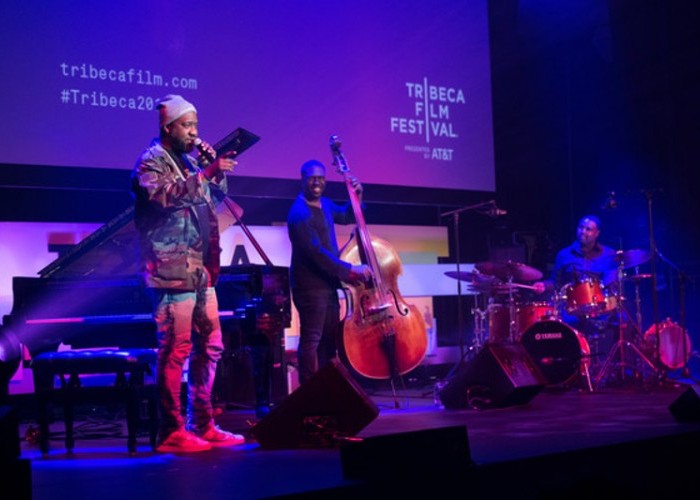Dec 9, 2025 12:28 PM
In Memoriam: Gordon Goodwin, 1954–2025
Gordon Goodwin, an award-winning saxophonist, pianist, bandleader, composer and arranger, died Dec. 8 in Los Angeles.…

Robert Glasper (left), Derrick Hodge and Kendrick Scott perform following a screening of the documentary Blue Note Records: Beyond The Notes at the Tribeca Film Festival on April 23.
(Photo: Courtesy Tribeca Film Festival)UPDATE: The theatrical run begins June 14 in New York at Metrograph. June 28, the film opens in Los Angles at Laemmle Monica Film Center and then rolls out through the rest of the summer across the U.S.
Blue Note Records arguably is one of the most iconic record labels in music history. Home to jazz greats like John Coltrane, Thelonious Monk, Robert Glasper and Norah Jones, the imprint has been a catalyst for American creativity since 1939, when it was founded by Alfred Lion and Francis Wolff.
Now, the label is the focus of Blue Note Records: Beyond The Notes, a documentary directed by Sophie Huber, which premiered in New York at the Tribeca Film Festival on April 23.
Two hours prior to the film beginning, a line formed outside the Tribeca Festival Hub, mimicking a crowd congregating for a major theatrical release. After the lights dimmed, though, Frederic Boyer, artistic director of the festival, welcomed the audience and offered his take on the documentary.
“If you like jazz, you’ll love the film,” he said. “If you don’t like jazz, you’ll love the film.”
A short applause followed, and he introduced Huber to the crowd.
Huber, also one of the film’s producers, appeared before the audience and in a faint, Swiss accent shared her appreciation for all the work involved in making the film. She went on to explain that she essentially got the gig from Don Was, president of Blue Note, about three years ago, emphasizing the fact that it took time to effectively craft her vision.
“Thank you,” she said jokingly to Was. “I will never forgive you.”
The opening scene of Beyond The Notes depicts the Blue Note All-Stars’ 2017 recording session at Capitol Studios in Los Angeles. Was appears, hovering over the session while explaining the origin of the super-group. Including keyboardist Robert Glasper, trumpeter Ambrose Akinmusire, saxophonist Marcus Strickland, guitarist Lionel Loueke, bassist Derrick Hodge and drummer Kendrick Scott, the Blue Note All-Stars formed in 2014 to mark the 75th anniversary of the legendary jazz label.
Beyond The Notes holds true to its name, diving into the label’s rich past, but also commenting on the transition that the genre has made since the label’s inception. Freedom and what it means to musicians was a frequent topic throughout the documentary, often being equated with power. Each performer’s talent and their appreciation of the artform, as well as the founders’ work, was explored through audio clips, archival performance footage and present-day interviews with performers like Herbie Hancock and Wayne Shorter.
It’s all connected with a fitting Blue Note soundtrack and flashes of co-founder Wolff’s photography.
“They were fans. They were rabid fans. I think they were just records that they wanted to hear. So, they decided that they were going to make them,” Was said in the film about some of the adventurous work Lion and Wolff facilitated over the years. “And I don’t think they ever lost the purity and the innocence that came with it. They understood the value of trusting in the musicians.”
Following the film, a fog machine was switched on, recreating the feel provided by scores of black and white photos that flickered across the screen during the film. Was emerged to introduce to the crowd “three of the greatest musicians of our time or of any era in Blue Note Records: Derrick Hodge, Kendrick Scott and Robert Glasper.”
The trio began by playing a medley of songs inspired or made famous by former Blue Note players, including Coltrane and Monk, before playing some of their own tunes.
“There’s a marriage between jazz and hip-hop, and I’m an advocate for that,” Glasper told the crowd after playing a handful of songs. “I’m also an advocate for giving young artists a chance in this music—and people that are not necessarily known.”
Glasper then, in jest, introduced Academy Award-winning hip-hop artist Common. And, instead of performing one of his hits, the Chicago rapper opted to freestyle—in true jazz form.
As hip-hop continues to dominate much of popular music, Blue Note Records: Beyond The Notes offers an unguarded look at what it takes to create freely and the impact that such artistry has on subsequent generations. DB

Goodwin was one of the most acclaimed, successful and influential jazz musicians of his generation.
Dec 9, 2025 12:28 PM
Gordon Goodwin, an award-winning saxophonist, pianist, bandleader, composer and arranger, died Dec. 8 in Los Angeles.…

Nov 13, 2025 10:00 AM
For results of DownBeat’s 90th Annual Readers Poll, complete with feature articles from our December 2025 issue,…

Flea has returned to his first instrument — the trumpet — and assembled a dream band of jazz musicians to record a new album.
Dec 2, 2025 2:01 AM
After a nearly five-decade career as one of his generation’s defining rock bassists, Flea has returned to his first…

“It’s a pleasure and an honor to interpret the music of Oscar Peterson in his native city,” said Jim Doxas in regard to celebrating the Canadian legend. “He traveled the world, but never forgot Montreal.”
Nov 18, 2025 12:16 PM
In the pantheon of jazz luminaries, few shine as brightly, or swing as hard, as Oscar Peterson. A century ago, a…

Dec 11, 2025 11:00 AM
DownBeat presents a complete list of the 4-, 4½- and 5-star albums from 2025 in one convenient package. It’s a great…